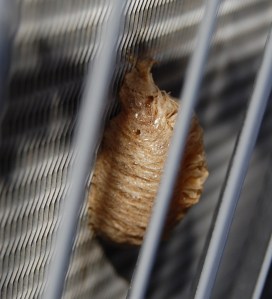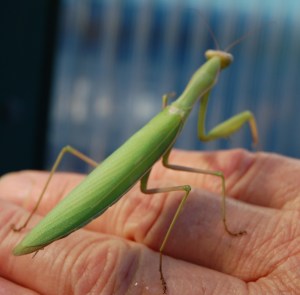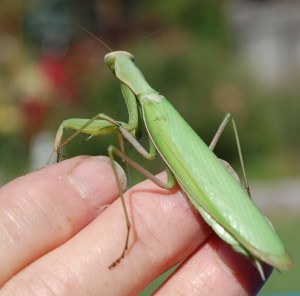Springtime not only brings thoughts of flowering crocus, daffodils and tulips, but of spring cleaning in the garden. Left behind from fall and winter are masses of leaves, twigs, needles and blown trash stuck in every nook and cranny in our gardens. Spring is the time to clear away the debris so new life can emerge from the warming soil to once again brighten our gardens.
While doing your Spring cleaning in your garden not only be vigilant with your cleaning, but also look for overwintering insect eggs. One in particular is the Mantids or you may know it by its commonly referred name the “Praying Mantis”. If you are fortunate enough to discover one do not destroy it. The Mantids are one of the best beneficial insects to have in your garden.
There are at least six species of mantids found in Colorado. Mantids are ferocious predators that feed on a variety of insects, including the pests that want to destroy our the plants in our garden. Mantids come in various sizes from over 3″ to 1.5 inches. They come in colors of green and brown.
The most prevalent species found in Colorado is the European mantid the true Praying Mantis. This variety is rather large, exceeding three inches when full grown and comes in green or brown forms. This variety can easily be identified by a “bull’s-eye” under the fore leg.
Mantids are some of the most well-recognized and distinguishably of all the insect groups. The front grasping legs are what captures everyone’s eyes when they spot a mantid. The legs are well-designed for grasping and holding their prey. They also have this uncanny ability to turn their triangular-shaped heads in order to see in all directions.
Mantids survive our cold winters as eggs. The eggs are laid in masses, known as oothecae. The oothecae is covered in a foamy material making them look like a “packing peanut”. They are attached to solid surfaces such as buildings, dried plant life, or in my case my central air conditioner unit.
 Generally the eggs hatch in late spring, or earlier depending on the weather or if they are located in a secluded warm area. Once they hatch the offspring called “nymphs” feast on small gnats, other insects or sometimes cannibalizing on other nymphs emerging from the egg.
Generally the eggs hatch in late spring, or earlier depending on the weather or if they are located in a secluded warm area. Once they hatch the offspring called “nymphs” feast on small gnats, other insects or sometimes cannibalizing on other nymphs emerging from the egg.
Survival is a major factor with mantids, so the use of camouflage and concealment play a vital role in their existence. Their protective coloration allows them to blend in with the surrounding vegetation to avoid predators, but also to conceal themselves from their prey.
They also display a rocking behavior, in which they make rhythmic, repetitive side-to-side movements. This rocking movement allows them to resemble vegetation swaying in the wind.
 Us as gardeners can encourage mantises as a form of biological pest control by not using toxic pesticides in our gardens. So when doing your spring cleaning in your gardens keep a keen eye out for the mantids oothecae. You could have a natural and free insect control in your garden. Not a lot of gardeners are fortunate for mantids to take up residence in their gardens, but don’t be disheartened mantids eggs can be purchased from garden catalogs and some nurseries.
Us as gardeners can encourage mantises as a form of biological pest control by not using toxic pesticides in our gardens. So when doing your spring cleaning in your gardens keep a keen eye out for the mantids oothecae. You could have a natural and free insect control in your garden. Not a lot of gardeners are fortunate for mantids to take up residence in their gardens, but don’t be disheartened mantids eggs can be purchased from garden catalogs and some nurseries.
Filed under: Insects in the Garden | Tagged: Beneficial Insects, Colorado Gardening, Colorado Springs, Spring gardening | Leave a comment »



